Managing a Classroom Environment
VerifiedAdded on 2023/01/18
|14
|4425
|70
AI Summary
This article examines the positive and proactive methods used by teachers to develop a positive classroom environment that supports students' academic and social development. It discusses the importance of a positive environment, the impact of teacher intervention, and recommendations for improvement. The article also discusses how the teacher addresses AITSL's Graduate Teaching Standards 1.1, 3.5, and 4.3.
Contribute Materials
Your contribution can guide someone’s learning journey. Share your
documents today.
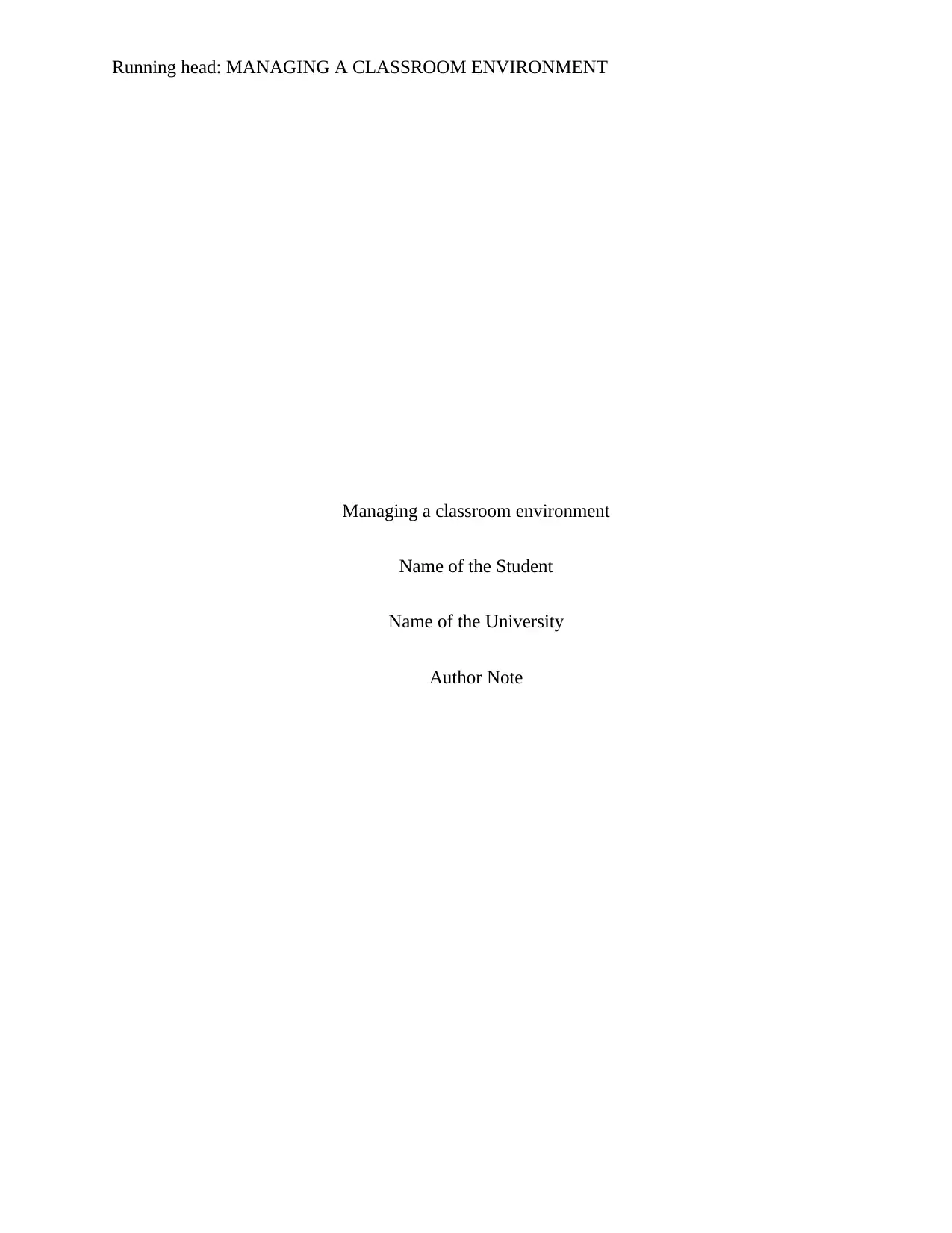
Running head: MANAGING A CLASSROOM ENVIRONMENT
Managing a classroom environment
Name of the Student
Name of the University
Author Note
Managing a classroom environment
Name of the Student
Name of the University
Author Note
Secure Best Marks with AI Grader
Need help grading? Try our AI Grader for instant feedback on your assignments.
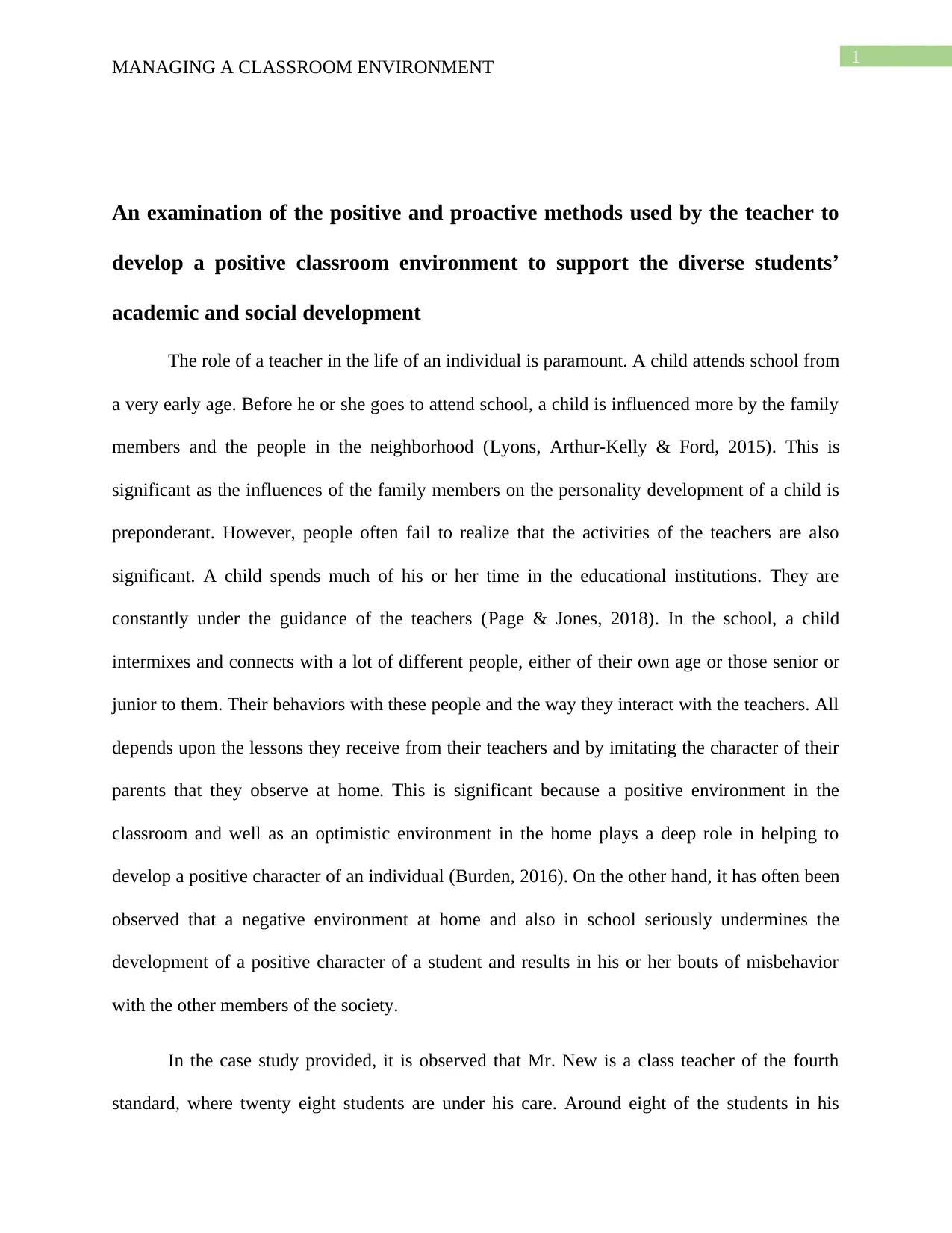
1
MANAGING A CLASSROOM ENVIRONMENT
An examination of the positive and proactive methods used by the teacher to
develop a positive classroom environment to support the diverse students’
academic and social development
The role of a teacher in the life of an individual is paramount. A child attends school from
a very early age. Before he or she goes to attend school, a child is influenced more by the family
members and the people in the neighborhood (Lyons, Arthur-Kelly & Ford, 2015). This is
significant as the influences of the family members on the personality development of a child is
preponderant. However, people often fail to realize that the activities of the teachers are also
significant. A child spends much of his or her time in the educational institutions. They are
constantly under the guidance of the teachers (Page & Jones, 2018). In the school, a child
intermixes and connects with a lot of different people, either of their own age or those senior or
junior to them. Their behaviors with these people and the way they interact with the teachers. All
depends upon the lessons they receive from their teachers and by imitating the character of their
parents that they observe at home. This is significant because a positive environment in the
classroom and well as an optimistic environment in the home plays a deep role in helping to
develop a positive character of an individual (Burden, 2016). On the other hand, it has often been
observed that a negative environment at home and also in school seriously undermines the
development of a positive character of a student and results in his or her bouts of misbehavior
with the other members of the society.
In the case study provided, it is observed that Mr. New is a class teacher of the fourth
standard, where twenty eight students are under his care. Around eight of the students in his
MANAGING A CLASSROOM ENVIRONMENT
An examination of the positive and proactive methods used by the teacher to
develop a positive classroom environment to support the diverse students’
academic and social development
The role of a teacher in the life of an individual is paramount. A child attends school from
a very early age. Before he or she goes to attend school, a child is influenced more by the family
members and the people in the neighborhood (Lyons, Arthur-Kelly & Ford, 2015). This is
significant as the influences of the family members on the personality development of a child is
preponderant. However, people often fail to realize that the activities of the teachers are also
significant. A child spends much of his or her time in the educational institutions. They are
constantly under the guidance of the teachers (Page & Jones, 2018). In the school, a child
intermixes and connects with a lot of different people, either of their own age or those senior or
junior to them. Their behaviors with these people and the way they interact with the teachers. All
depends upon the lessons they receive from their teachers and by imitating the character of their
parents that they observe at home. This is significant because a positive environment in the
classroom and well as an optimistic environment in the home plays a deep role in helping to
develop a positive character of an individual (Burden, 2016). On the other hand, it has often been
observed that a negative environment at home and also in school seriously undermines the
development of a positive character of a student and results in his or her bouts of misbehavior
with the other members of the society.
In the case study provided, it is observed that Mr. New is a class teacher of the fourth
standard, where twenty eight students are under his care. Around eight of the students in his
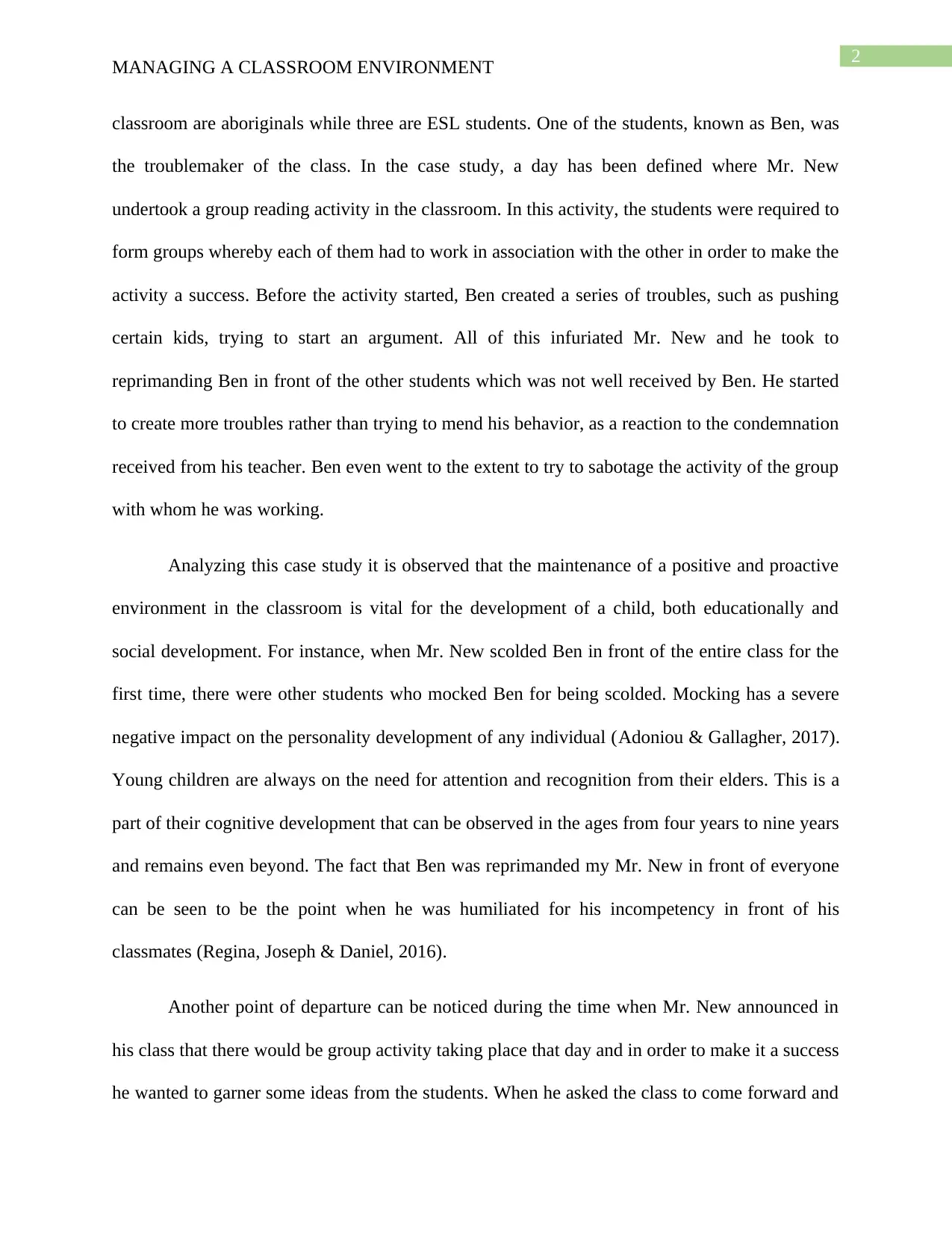
2
MANAGING A CLASSROOM ENVIRONMENT
classroom are aboriginals while three are ESL students. One of the students, known as Ben, was
the troublemaker of the class. In the case study, a day has been defined where Mr. New
undertook a group reading activity in the classroom. In this activity, the students were required to
form groups whereby each of them had to work in association with the other in order to make the
activity a success. Before the activity started, Ben created a series of troubles, such as pushing
certain kids, trying to start an argument. All of this infuriated Mr. New and he took to
reprimanding Ben in front of the other students which was not well received by Ben. He started
to create more troubles rather than trying to mend his behavior, as a reaction to the condemnation
received from his teacher. Ben even went to the extent to try to sabotage the activity of the group
with whom he was working.
Analyzing this case study it is observed that the maintenance of a positive and proactive
environment in the classroom is vital for the development of a child, both educationally and
social development. For instance, when Mr. New scolded Ben in front of the entire class for the
first time, there were other students who mocked Ben for being scolded. Mocking has a severe
negative impact on the personality development of any individual (Adoniou & Gallagher, 2017).
Young children are always on the need for attention and recognition from their elders. This is a
part of their cognitive development that can be observed in the ages from four years to nine years
and remains even beyond. The fact that Ben was reprimanded my Mr. New in front of everyone
can be seen to be the point when he was humiliated for his incompetency in front of his
classmates (Regina, Joseph & Daniel, 2016).
Another point of departure can be noticed during the time when Mr. New announced in
his class that there would be group activity taking place that day and in order to make it a success
he wanted to garner some ideas from the students. When he asked the class to come forward and
MANAGING A CLASSROOM ENVIRONMENT
classroom are aboriginals while three are ESL students. One of the students, known as Ben, was
the troublemaker of the class. In the case study, a day has been defined where Mr. New
undertook a group reading activity in the classroom. In this activity, the students were required to
form groups whereby each of them had to work in association with the other in order to make the
activity a success. Before the activity started, Ben created a series of troubles, such as pushing
certain kids, trying to start an argument. All of this infuriated Mr. New and he took to
reprimanding Ben in front of the other students which was not well received by Ben. He started
to create more troubles rather than trying to mend his behavior, as a reaction to the condemnation
received from his teacher. Ben even went to the extent to try to sabotage the activity of the group
with whom he was working.
Analyzing this case study it is observed that the maintenance of a positive and proactive
environment in the classroom is vital for the development of a child, both educationally and
social development. For instance, when Mr. New scolded Ben in front of the entire class for the
first time, there were other students who mocked Ben for being scolded. Mocking has a severe
negative impact on the personality development of any individual (Adoniou & Gallagher, 2017).
Young children are always on the need for attention and recognition from their elders. This is a
part of their cognitive development that can be observed in the ages from four years to nine years
and remains even beyond. The fact that Ben was reprimanded my Mr. New in front of everyone
can be seen to be the point when he was humiliated for his incompetency in front of his
classmates (Regina, Joseph & Daniel, 2016).
Another point of departure can be noticed during the time when Mr. New announced in
his class that there would be group activity taking place that day and in order to make it a success
he wanted to garner some ideas from the students. When he asked the class to come forward and
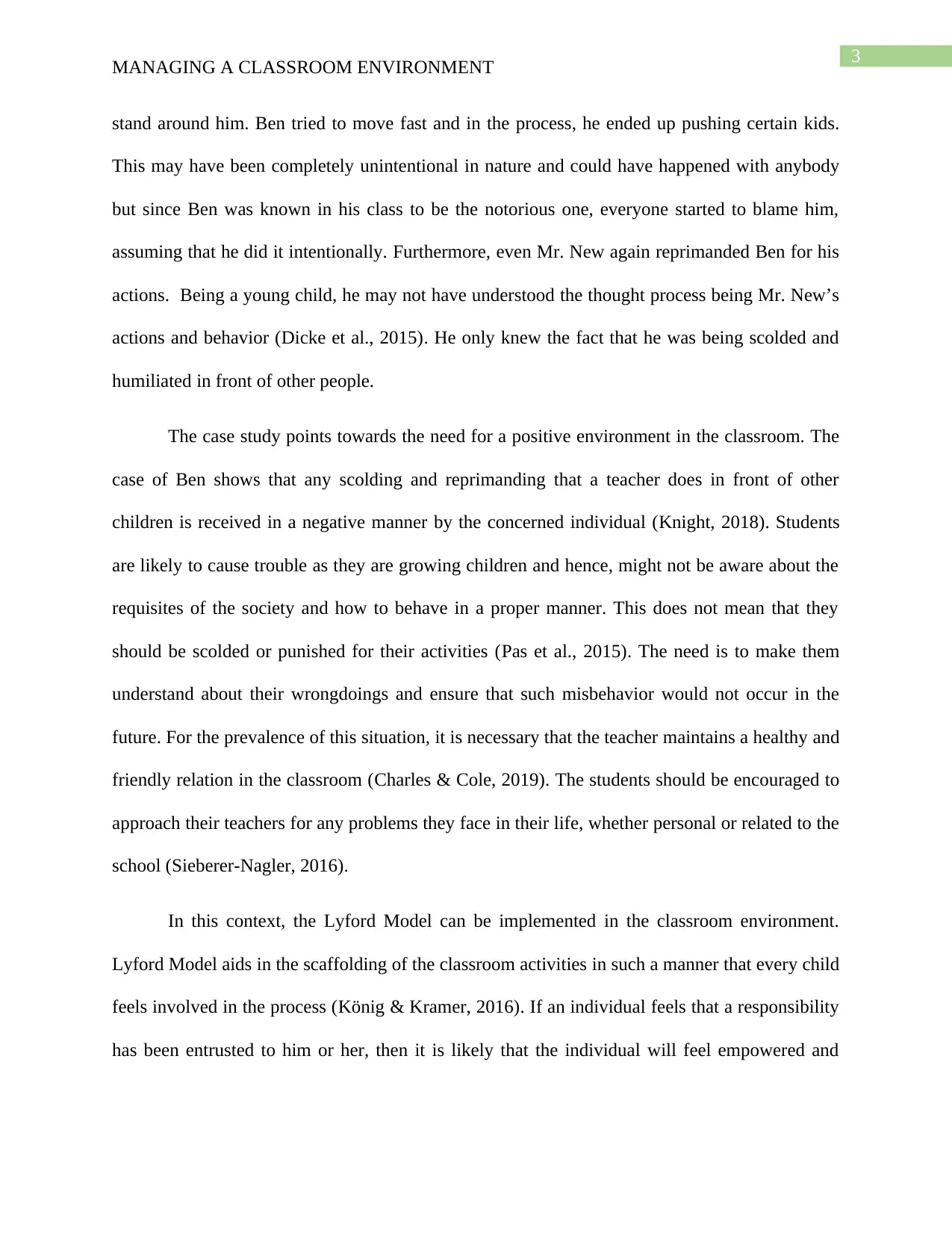
3
MANAGING A CLASSROOM ENVIRONMENT
stand around him. Ben tried to move fast and in the process, he ended up pushing certain kids.
This may have been completely unintentional in nature and could have happened with anybody
but since Ben was known in his class to be the notorious one, everyone started to blame him,
assuming that he did it intentionally. Furthermore, even Mr. New again reprimanded Ben for his
actions. Being a young child, he may not have understood the thought process being Mr. New’s
actions and behavior (Dicke et al., 2015). He only knew the fact that he was being scolded and
humiliated in front of other people.
The case study points towards the need for a positive environment in the classroom. The
case of Ben shows that any scolding and reprimanding that a teacher does in front of other
children is received in a negative manner by the concerned individual (Knight, 2018). Students
are likely to cause trouble as they are growing children and hence, might not be aware about the
requisites of the society and how to behave in a proper manner. This does not mean that they
should be scolded or punished for their activities (Pas et al., 2015). The need is to make them
understand about their wrongdoings and ensure that such misbehavior would not occur in the
future. For the prevalence of this situation, it is necessary that the teacher maintains a healthy and
friendly relation in the classroom (Charles & Cole, 2019). The students should be encouraged to
approach their teachers for any problems they face in their life, whether personal or related to the
school (Sieberer-Nagler, 2016).
In this context, the Lyford Model can be implemented in the classroom environment.
Lyford Model aids in the scaffolding of the classroom activities in such a manner that every child
feels involved in the process (König & Kramer, 2016). If an individual feels that a responsibility
has been entrusted to him or her, then it is likely that the individual will feel empowered and
MANAGING A CLASSROOM ENVIRONMENT
stand around him. Ben tried to move fast and in the process, he ended up pushing certain kids.
This may have been completely unintentional in nature and could have happened with anybody
but since Ben was known in his class to be the notorious one, everyone started to blame him,
assuming that he did it intentionally. Furthermore, even Mr. New again reprimanded Ben for his
actions. Being a young child, he may not have understood the thought process being Mr. New’s
actions and behavior (Dicke et al., 2015). He only knew the fact that he was being scolded and
humiliated in front of other people.
The case study points towards the need for a positive environment in the classroom. The
case of Ben shows that any scolding and reprimanding that a teacher does in front of other
children is received in a negative manner by the concerned individual (Knight, 2018). Students
are likely to cause trouble as they are growing children and hence, might not be aware about the
requisites of the society and how to behave in a proper manner. This does not mean that they
should be scolded or punished for their activities (Pas et al., 2015). The need is to make them
understand about their wrongdoings and ensure that such misbehavior would not occur in the
future. For the prevalence of this situation, it is necessary that the teacher maintains a healthy and
friendly relation in the classroom (Charles & Cole, 2019). The students should be encouraged to
approach their teachers for any problems they face in their life, whether personal or related to the
school (Sieberer-Nagler, 2016).
In this context, the Lyford Model can be implemented in the classroom environment.
Lyford Model aids in the scaffolding of the classroom activities in such a manner that every child
feels involved in the process (König & Kramer, 2016). If an individual feels that a responsibility
has been entrusted to him or her, then it is likely that the individual will feel empowered and
Secure Best Marks with AI Grader
Need help grading? Try our AI Grader for instant feedback on your assignments.
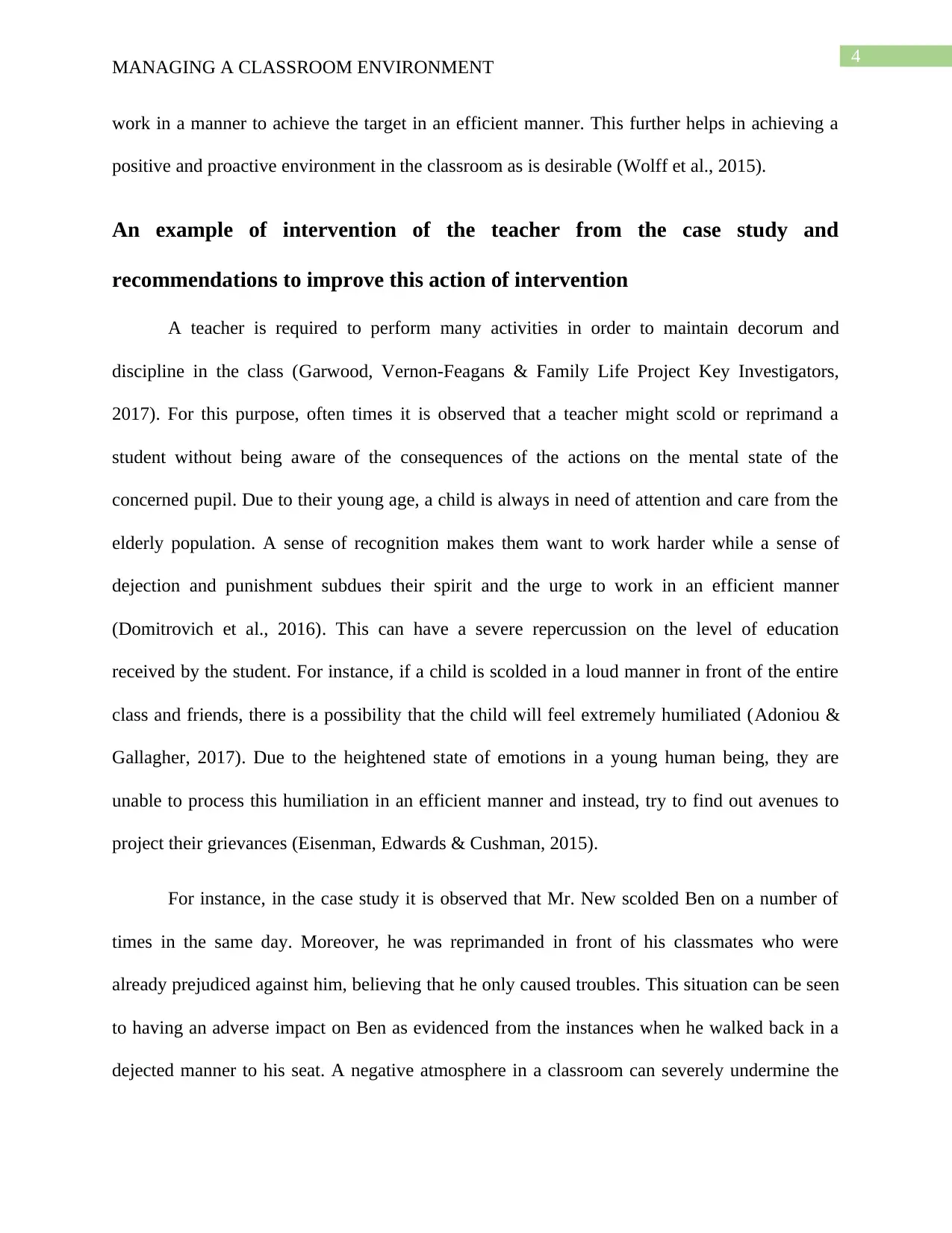
4
MANAGING A CLASSROOM ENVIRONMENT
work in a manner to achieve the target in an efficient manner. This further helps in achieving a
positive and proactive environment in the classroom as is desirable (Wolff et al., 2015).
An example of intervention of the teacher from the case study and
recommendations to improve this action of intervention
A teacher is required to perform many activities in order to maintain decorum and
discipline in the class (Garwood, Vernon-Feagans & Family Life Project Key Investigators,
2017). For this purpose, often times it is observed that a teacher might scold or reprimand a
student without being aware of the consequences of the actions on the mental state of the
concerned pupil. Due to their young age, a child is always in need of attention and care from the
elderly population. A sense of recognition makes them want to work harder while a sense of
dejection and punishment subdues their spirit and the urge to work in an efficient manner
(Domitrovich et al., 2016). This can have a severe repercussion on the level of education
received by the student. For instance, if a child is scolded in a loud manner in front of the entire
class and friends, there is a possibility that the child will feel extremely humiliated (Adoniou &
Gallagher, 2017). Due to the heightened state of emotions in a young human being, they are
unable to process this humiliation in an efficient manner and instead, try to find out avenues to
project their grievances (Eisenman, Edwards & Cushman, 2015).
For instance, in the case study it is observed that Mr. New scolded Ben on a number of
times in the same day. Moreover, he was reprimanded in front of his classmates who were
already prejudiced against him, believing that he only caused troubles. This situation can be seen
to having an adverse impact on Ben as evidenced from the instances when he walked back in a
dejected manner to his seat. A negative atmosphere in a classroom can severely undermine the
MANAGING A CLASSROOM ENVIRONMENT
work in a manner to achieve the target in an efficient manner. This further helps in achieving a
positive and proactive environment in the classroom as is desirable (Wolff et al., 2015).
An example of intervention of the teacher from the case study and
recommendations to improve this action of intervention
A teacher is required to perform many activities in order to maintain decorum and
discipline in the class (Garwood, Vernon-Feagans & Family Life Project Key Investigators,
2017). For this purpose, often times it is observed that a teacher might scold or reprimand a
student without being aware of the consequences of the actions on the mental state of the
concerned pupil. Due to their young age, a child is always in need of attention and care from the
elderly population. A sense of recognition makes them want to work harder while a sense of
dejection and punishment subdues their spirit and the urge to work in an efficient manner
(Domitrovich et al., 2016). This can have a severe repercussion on the level of education
received by the student. For instance, if a child is scolded in a loud manner in front of the entire
class and friends, there is a possibility that the child will feel extremely humiliated (Adoniou &
Gallagher, 2017). Due to the heightened state of emotions in a young human being, they are
unable to process this humiliation in an efficient manner and instead, try to find out avenues to
project their grievances (Eisenman, Edwards & Cushman, 2015).
For instance, in the case study it is observed that Mr. New scolded Ben on a number of
times in the same day. Moreover, he was reprimanded in front of his classmates who were
already prejudiced against him, believing that he only caused troubles. This situation can be seen
to having an adverse impact on Ben as evidenced from the instances when he walked back in a
dejected manner to his seat. A negative atmosphere in a classroom can severely undermine the
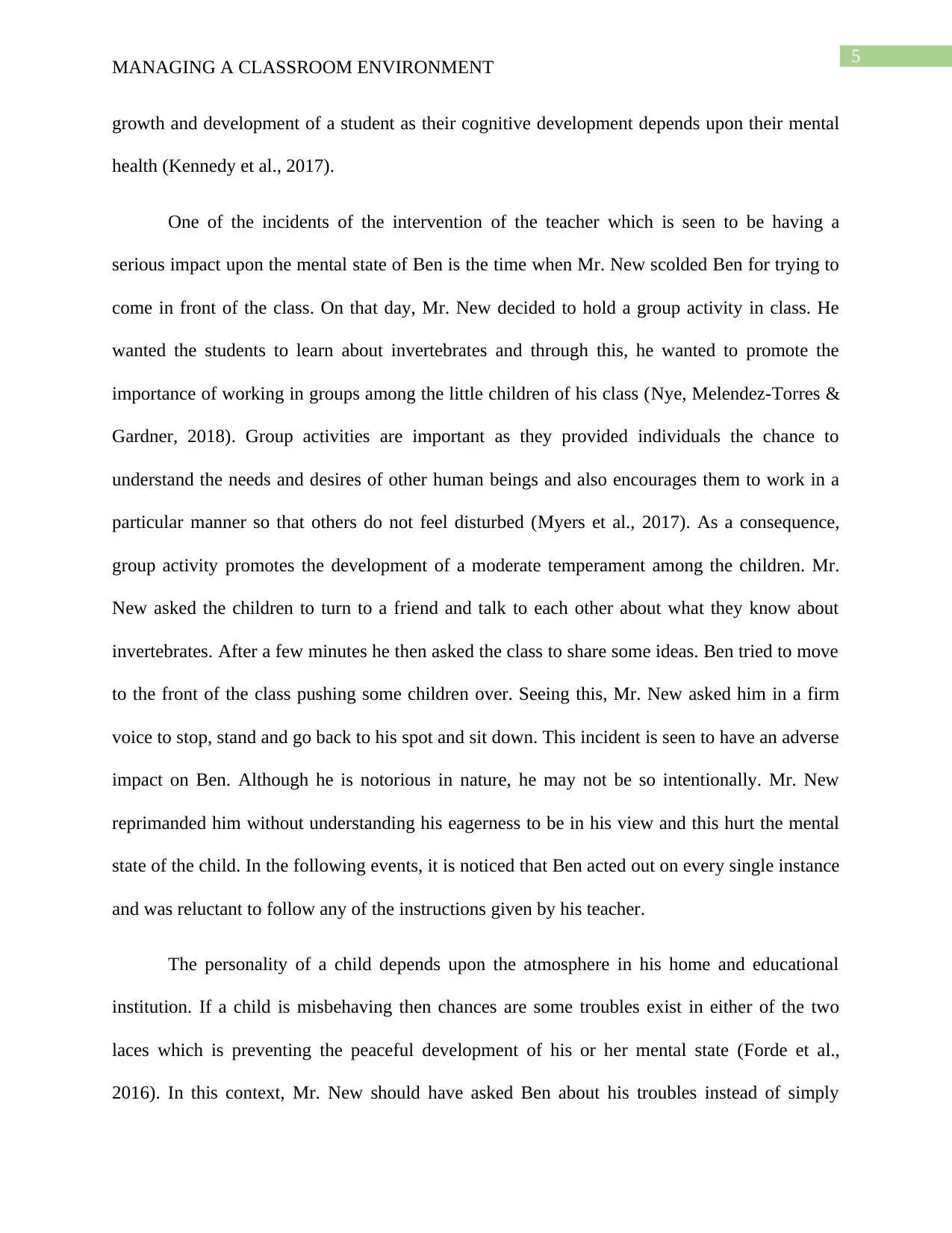
5
MANAGING A CLASSROOM ENVIRONMENT
growth and development of a student as their cognitive development depends upon their mental
health (Kennedy et al., 2017).
One of the incidents of the intervention of the teacher which is seen to be having a
serious impact upon the mental state of Ben is the time when Mr. New scolded Ben for trying to
come in front of the class. On that day, Mr. New decided to hold a group activity in class. He
wanted the students to learn about invertebrates and through this, he wanted to promote the
importance of working in groups among the little children of his class (Nye, Melendez-Torres &
Gardner, 2018). Group activities are important as they provided individuals the chance to
understand the needs and desires of other human beings and also encourages them to work in a
particular manner so that others do not feel disturbed (Myers et al., 2017). As a consequence,
group activity promotes the development of a moderate temperament among the children. Mr.
New asked the children to turn to a friend and talk to each other about what they know about
invertebrates. After a few minutes he then asked the class to share some ideas. Ben tried to move
to the front of the class pushing some children over. Seeing this, Mr. New asked him in a firm
voice to stop, stand and go back to his spot and sit down. This incident is seen to have an adverse
impact on Ben. Although he is notorious in nature, he may not be so intentionally. Mr. New
reprimanded him without understanding his eagerness to be in his view and this hurt the mental
state of the child. In the following events, it is noticed that Ben acted out on every single instance
and was reluctant to follow any of the instructions given by his teacher.
The personality of a child depends upon the atmosphere in his home and educational
institution. If a child is misbehaving then chances are some troubles exist in either of the two
laces which is preventing the peaceful development of his or her mental state (Forde et al.,
2016). In this context, Mr. New should have asked Ben about his troubles instead of simply
MANAGING A CLASSROOM ENVIRONMENT
growth and development of a student as their cognitive development depends upon their mental
health (Kennedy et al., 2017).
One of the incidents of the intervention of the teacher which is seen to be having a
serious impact upon the mental state of Ben is the time when Mr. New scolded Ben for trying to
come in front of the class. On that day, Mr. New decided to hold a group activity in class. He
wanted the students to learn about invertebrates and through this, he wanted to promote the
importance of working in groups among the little children of his class (Nye, Melendez-Torres &
Gardner, 2018). Group activities are important as they provided individuals the chance to
understand the needs and desires of other human beings and also encourages them to work in a
particular manner so that others do not feel disturbed (Myers et al., 2017). As a consequence,
group activity promotes the development of a moderate temperament among the children. Mr.
New asked the children to turn to a friend and talk to each other about what they know about
invertebrates. After a few minutes he then asked the class to share some ideas. Ben tried to move
to the front of the class pushing some children over. Seeing this, Mr. New asked him in a firm
voice to stop, stand and go back to his spot and sit down. This incident is seen to have an adverse
impact on Ben. Although he is notorious in nature, he may not be so intentionally. Mr. New
reprimanded him without understanding his eagerness to be in his view and this hurt the mental
state of the child. In the following events, it is noticed that Ben acted out on every single instance
and was reluctant to follow any of the instructions given by his teacher.
The personality of a child depends upon the atmosphere in his home and educational
institution. If a child is misbehaving then chances are some troubles exist in either of the two
laces which is preventing the peaceful development of his or her mental state (Forde et al.,
2016). In this context, Mr. New should have asked Ben about his troubles instead of simply
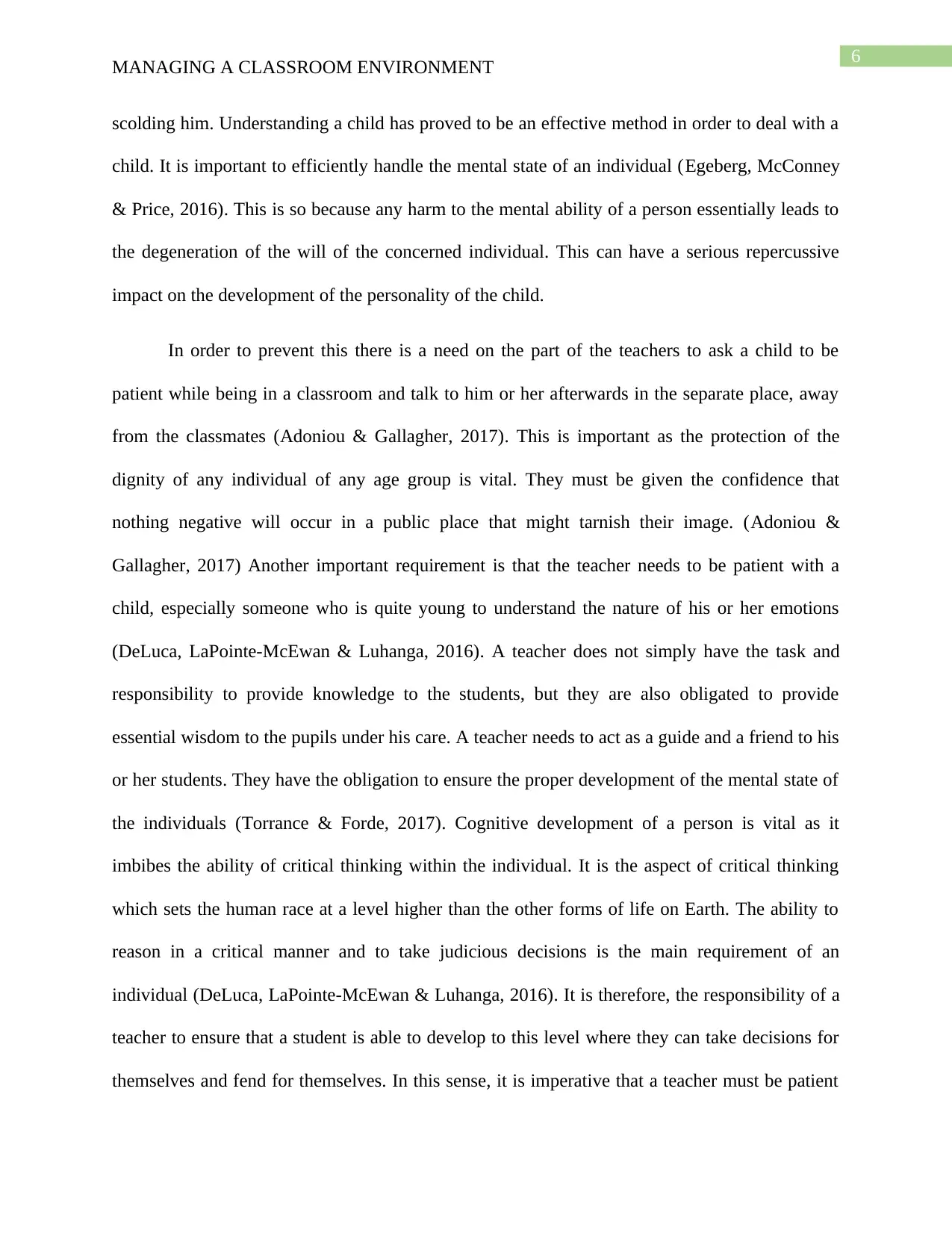
6
MANAGING A CLASSROOM ENVIRONMENT
scolding him. Understanding a child has proved to be an effective method in order to deal with a
child. It is important to efficiently handle the mental state of an individual (Egeberg, McConney
& Price, 2016). This is so because any harm to the mental ability of a person essentially leads to
the degeneration of the will of the concerned individual. This can have a serious repercussive
impact on the development of the personality of the child.
In order to prevent this there is a need on the part of the teachers to ask a child to be
patient while being in a classroom and talk to him or her afterwards in the separate place, away
from the classmates (Adoniou & Gallagher, 2017). This is important as the protection of the
dignity of any individual of any age group is vital. They must be given the confidence that
nothing negative will occur in a public place that might tarnish their image. (Adoniou &
Gallagher, 2017) Another important requirement is that the teacher needs to be patient with a
child, especially someone who is quite young to understand the nature of his or her emotions
(DeLuca, LaPointe-McEwan & Luhanga, 2016). A teacher does not simply have the task and
responsibility to provide knowledge to the students, but they are also obligated to provide
essential wisdom to the pupils under his care. A teacher needs to act as a guide and a friend to his
or her students. They have the obligation to ensure the proper development of the mental state of
the individuals (Torrance & Forde, 2017). Cognitive development of a person is vital as it
imbibes the ability of critical thinking within the individual. It is the aspect of critical thinking
which sets the human race at a level higher than the other forms of life on Earth. The ability to
reason in a critical manner and to take judicious decisions is the main requirement of an
individual (DeLuca, LaPointe-McEwan & Luhanga, 2016). It is therefore, the responsibility of a
teacher to ensure that a student is able to develop to this level where they can take decisions for
themselves and fend for themselves. In this sense, it is imperative that a teacher must be patient
MANAGING A CLASSROOM ENVIRONMENT
scolding him. Understanding a child has proved to be an effective method in order to deal with a
child. It is important to efficiently handle the mental state of an individual (Egeberg, McConney
& Price, 2016). This is so because any harm to the mental ability of a person essentially leads to
the degeneration of the will of the concerned individual. This can have a serious repercussive
impact on the development of the personality of the child.
In order to prevent this there is a need on the part of the teachers to ask a child to be
patient while being in a classroom and talk to him or her afterwards in the separate place, away
from the classmates (Adoniou & Gallagher, 2017). This is important as the protection of the
dignity of any individual of any age group is vital. They must be given the confidence that
nothing negative will occur in a public place that might tarnish their image. (Adoniou &
Gallagher, 2017) Another important requirement is that the teacher needs to be patient with a
child, especially someone who is quite young to understand the nature of his or her emotions
(DeLuca, LaPointe-McEwan & Luhanga, 2016). A teacher does not simply have the task and
responsibility to provide knowledge to the students, but they are also obligated to provide
essential wisdom to the pupils under his care. A teacher needs to act as a guide and a friend to his
or her students. They have the obligation to ensure the proper development of the mental state of
the individuals (Torrance & Forde, 2017). Cognitive development of a person is vital as it
imbibes the ability of critical thinking within the individual. It is the aspect of critical thinking
which sets the human race at a level higher than the other forms of life on Earth. The ability to
reason in a critical manner and to take judicious decisions is the main requirement of an
individual (DeLuca, LaPointe-McEwan & Luhanga, 2016). It is therefore, the responsibility of a
teacher to ensure that a student is able to develop to this level where they can take decisions for
themselves and fend for themselves. In this sense, it is imperative that a teacher must be patient
Paraphrase This Document
Need a fresh take? Get an instant paraphrase of this document with our AI Paraphraser
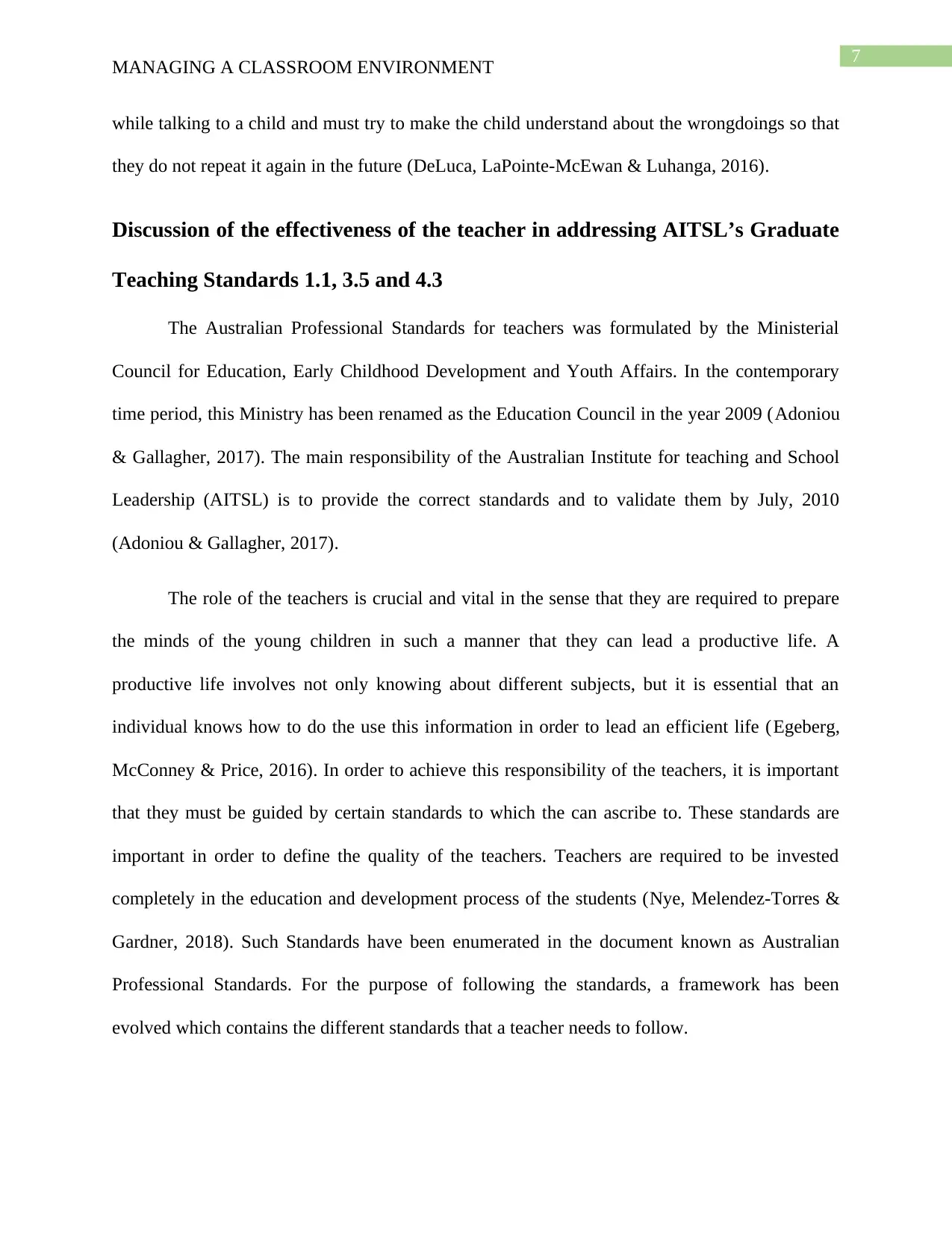
7
MANAGING A CLASSROOM ENVIRONMENT
while talking to a child and must try to make the child understand about the wrongdoings so that
they do not repeat it again in the future (DeLuca, LaPointe-McEwan & Luhanga, 2016).
Discussion of the effectiveness of the teacher in addressing AITSL’s Graduate
Teaching Standards 1.1, 3.5 and 4.3
The Australian Professional Standards for teachers was formulated by the Ministerial
Council for Education, Early Childhood Development and Youth Affairs. In the contemporary
time period, this Ministry has been renamed as the Education Council in the year 2009 (Adoniou
& Gallagher, 2017). The main responsibility of the Australian Institute for teaching and School
Leadership (AITSL) is to provide the correct standards and to validate them by July, 2010
(Adoniou & Gallagher, 2017).
The role of the teachers is crucial and vital in the sense that they are required to prepare
the minds of the young children in such a manner that they can lead a productive life. A
productive life involves not only knowing about different subjects, but it is essential that an
individual knows how to do the use this information in order to lead an efficient life (Egeberg,
McConney & Price, 2016). In order to achieve this responsibility of the teachers, it is important
that they must be guided by certain standards to which the can ascribe to. These standards are
important in order to define the quality of the teachers. Teachers are required to be invested
completely in the education and development process of the students (Nye, Melendez-Torres &
Gardner, 2018). Such Standards have been enumerated in the document known as Australian
Professional Standards. For the purpose of following the standards, a framework has been
evolved which contains the different standards that a teacher needs to follow.
MANAGING A CLASSROOM ENVIRONMENT
while talking to a child and must try to make the child understand about the wrongdoings so that
they do not repeat it again in the future (DeLuca, LaPointe-McEwan & Luhanga, 2016).
Discussion of the effectiveness of the teacher in addressing AITSL’s Graduate
Teaching Standards 1.1, 3.5 and 4.3
The Australian Professional Standards for teachers was formulated by the Ministerial
Council for Education, Early Childhood Development and Youth Affairs. In the contemporary
time period, this Ministry has been renamed as the Education Council in the year 2009 (Adoniou
& Gallagher, 2017). The main responsibility of the Australian Institute for teaching and School
Leadership (AITSL) is to provide the correct standards and to validate them by July, 2010
(Adoniou & Gallagher, 2017).
The role of the teachers is crucial and vital in the sense that they are required to prepare
the minds of the young children in such a manner that they can lead a productive life. A
productive life involves not only knowing about different subjects, but it is essential that an
individual knows how to do the use this information in order to lead an efficient life (Egeberg,
McConney & Price, 2016). In order to achieve this responsibility of the teachers, it is important
that they must be guided by certain standards to which the can ascribe to. These standards are
important in order to define the quality of the teachers. Teachers are required to be invested
completely in the education and development process of the students (Nye, Melendez-Torres &
Gardner, 2018). Such Standards have been enumerated in the document known as Australian
Professional Standards. For the purpose of following the standards, a framework has been
evolved which contains the different standards that a teacher needs to follow.
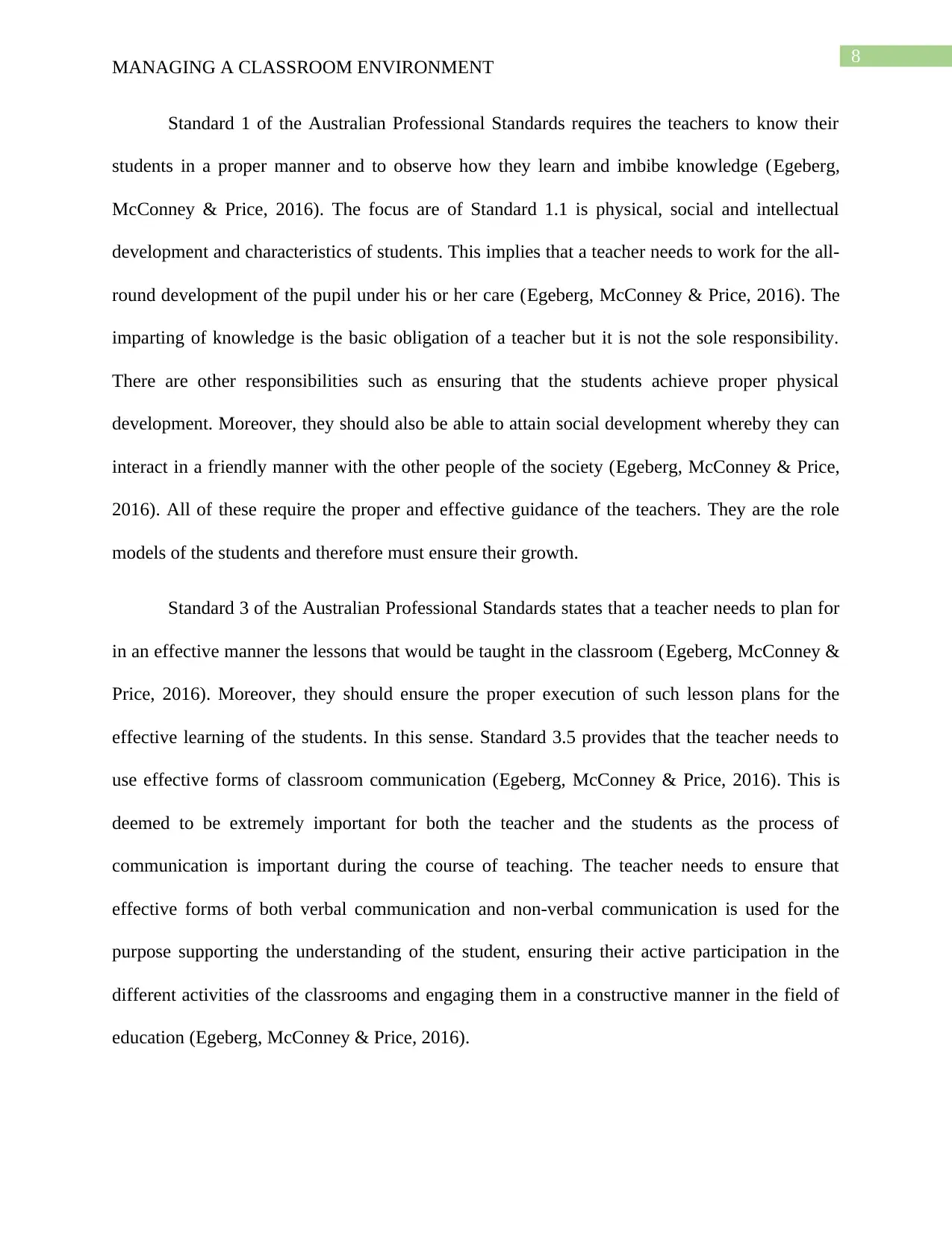
8
MANAGING A CLASSROOM ENVIRONMENT
Standard 1 of the Australian Professional Standards requires the teachers to know their
students in a proper manner and to observe how they learn and imbibe knowledge (Egeberg,
McConney & Price, 2016). The focus are of Standard 1.1 is physical, social and intellectual
development and characteristics of students. This implies that a teacher needs to work for the all-
round development of the pupil under his or her care (Egeberg, McConney & Price, 2016). The
imparting of knowledge is the basic obligation of a teacher but it is not the sole responsibility.
There are other responsibilities such as ensuring that the students achieve proper physical
development. Moreover, they should also be able to attain social development whereby they can
interact in a friendly manner with the other people of the society (Egeberg, McConney & Price,
2016). All of these require the proper and effective guidance of the teachers. They are the role
models of the students and therefore must ensure their growth.
Standard 3 of the Australian Professional Standards states that a teacher needs to plan for
in an effective manner the lessons that would be taught in the classroom (Egeberg, McConney &
Price, 2016). Moreover, they should ensure the proper execution of such lesson plans for the
effective learning of the students. In this sense. Standard 3.5 provides that the teacher needs to
use effective forms of classroom communication (Egeberg, McConney & Price, 2016). This is
deemed to be extremely important for both the teacher and the students as the process of
communication is important during the course of teaching. The teacher needs to ensure that
effective forms of both verbal communication and non-verbal communication is used for the
purpose supporting the understanding of the student, ensuring their active participation in the
different activities of the classrooms and engaging them in a constructive manner in the field of
education (Egeberg, McConney & Price, 2016).
MANAGING A CLASSROOM ENVIRONMENT
Standard 1 of the Australian Professional Standards requires the teachers to know their
students in a proper manner and to observe how they learn and imbibe knowledge (Egeberg,
McConney & Price, 2016). The focus are of Standard 1.1 is physical, social and intellectual
development and characteristics of students. This implies that a teacher needs to work for the all-
round development of the pupil under his or her care (Egeberg, McConney & Price, 2016). The
imparting of knowledge is the basic obligation of a teacher but it is not the sole responsibility.
There are other responsibilities such as ensuring that the students achieve proper physical
development. Moreover, they should also be able to attain social development whereby they can
interact in a friendly manner with the other people of the society (Egeberg, McConney & Price,
2016). All of these require the proper and effective guidance of the teachers. They are the role
models of the students and therefore must ensure their growth.
Standard 3 of the Australian Professional Standards states that a teacher needs to plan for
in an effective manner the lessons that would be taught in the classroom (Egeberg, McConney &
Price, 2016). Moreover, they should ensure the proper execution of such lesson plans for the
effective learning of the students. In this sense. Standard 3.5 provides that the teacher needs to
use effective forms of classroom communication (Egeberg, McConney & Price, 2016). This is
deemed to be extremely important for both the teacher and the students as the process of
communication is important during the course of teaching. The teacher needs to ensure that
effective forms of both verbal communication and non-verbal communication is used for the
purpose supporting the understanding of the student, ensuring their active participation in the
different activities of the classrooms and engaging them in a constructive manner in the field of
education (Egeberg, McConney & Price, 2016).
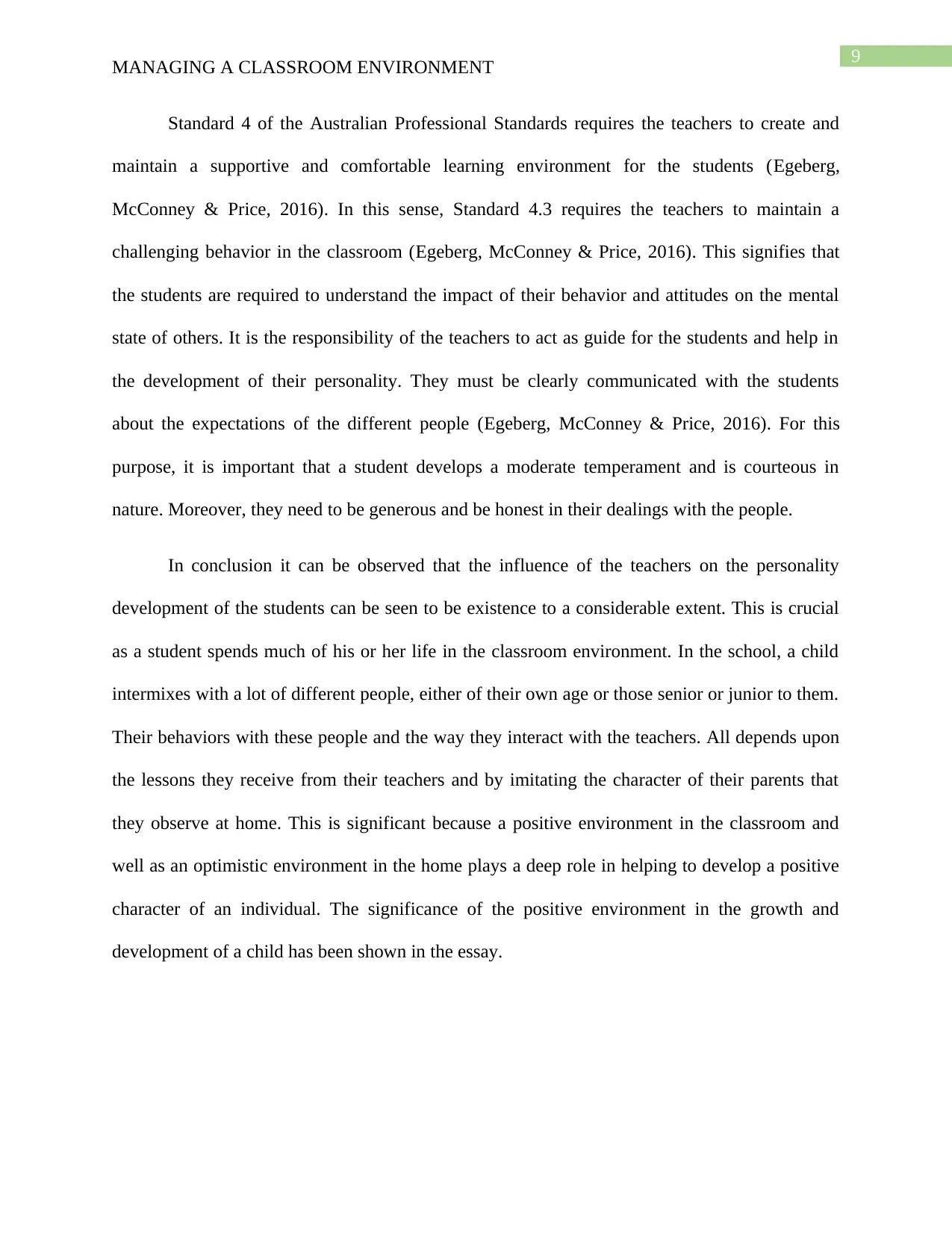
9
MANAGING A CLASSROOM ENVIRONMENT
Standard 4 of the Australian Professional Standards requires the teachers to create and
maintain a supportive and comfortable learning environment for the students (Egeberg,
McConney & Price, 2016). In this sense, Standard 4.3 requires the teachers to maintain a
challenging behavior in the classroom (Egeberg, McConney & Price, 2016). This signifies that
the students are required to understand the impact of their behavior and attitudes on the mental
state of others. It is the responsibility of the teachers to act as guide for the students and help in
the development of their personality. They must be clearly communicated with the students
about the expectations of the different people (Egeberg, McConney & Price, 2016). For this
purpose, it is important that a student develops a moderate temperament and is courteous in
nature. Moreover, they need to be generous and be honest in their dealings with the people.
In conclusion it can be observed that the influence of the teachers on the personality
development of the students can be seen to be existence to a considerable extent. This is crucial
as a student spends much of his or her life in the classroom environment. In the school, a child
intermixes with a lot of different people, either of their own age or those senior or junior to them.
Their behaviors with these people and the way they interact with the teachers. All depends upon
the lessons they receive from their teachers and by imitating the character of their parents that
they observe at home. This is significant because a positive environment in the classroom and
well as an optimistic environment in the home plays a deep role in helping to develop a positive
character of an individual. The significance of the positive environment in the growth and
development of a child has been shown in the essay.
MANAGING A CLASSROOM ENVIRONMENT
Standard 4 of the Australian Professional Standards requires the teachers to create and
maintain a supportive and comfortable learning environment for the students (Egeberg,
McConney & Price, 2016). In this sense, Standard 4.3 requires the teachers to maintain a
challenging behavior in the classroom (Egeberg, McConney & Price, 2016). This signifies that
the students are required to understand the impact of their behavior and attitudes on the mental
state of others. It is the responsibility of the teachers to act as guide for the students and help in
the development of their personality. They must be clearly communicated with the students
about the expectations of the different people (Egeberg, McConney & Price, 2016). For this
purpose, it is important that a student develops a moderate temperament and is courteous in
nature. Moreover, they need to be generous and be honest in their dealings with the people.
In conclusion it can be observed that the influence of the teachers on the personality
development of the students can be seen to be existence to a considerable extent. This is crucial
as a student spends much of his or her life in the classroom environment. In the school, a child
intermixes with a lot of different people, either of their own age or those senior or junior to them.
Their behaviors with these people and the way they interact with the teachers. All depends upon
the lessons they receive from their teachers and by imitating the character of their parents that
they observe at home. This is significant because a positive environment in the classroom and
well as an optimistic environment in the home plays a deep role in helping to develop a positive
character of an individual. The significance of the positive environment in the growth and
development of a child has been shown in the essay.
Secure Best Marks with AI Grader
Need help grading? Try our AI Grader for instant feedback on your assignments.
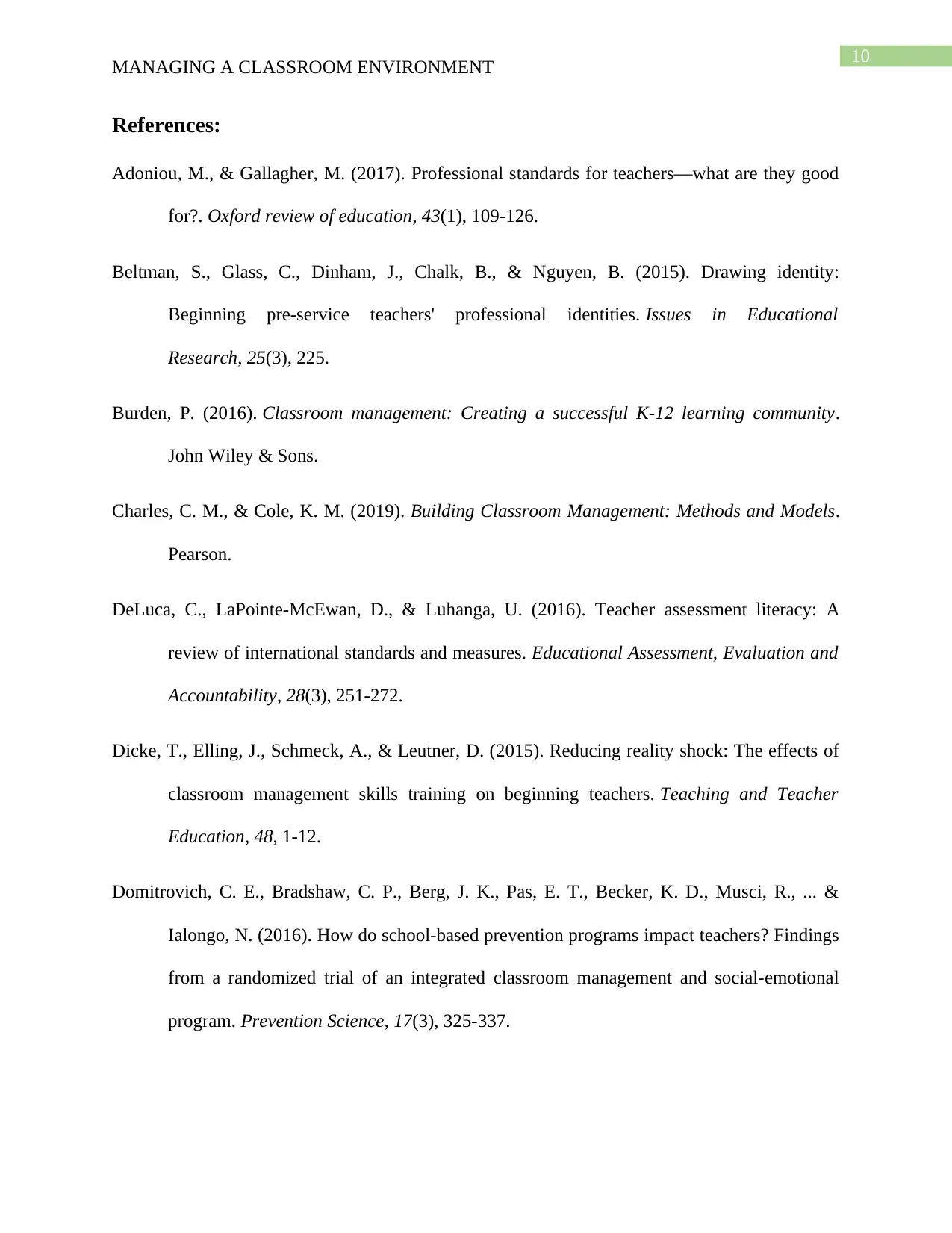
10
MANAGING A CLASSROOM ENVIRONMENT
References:
Adoniou, M., & Gallagher, M. (2017). Professional standards for teachers—what are they good
for?. Oxford review of education, 43(1), 109-126.
Beltman, S., Glass, C., Dinham, J., Chalk, B., & Nguyen, B. (2015). Drawing identity:
Beginning pre-service teachers' professional identities. Issues in Educational
Research, 25(3), 225.
Burden, P. (2016). Classroom management: Creating a successful K-12 learning community.
John Wiley & Sons.
Charles, C. M., & Cole, K. M. (2019). Building Classroom Management: Methods and Models.
Pearson.
DeLuca, C., LaPointe-McEwan, D., & Luhanga, U. (2016). Teacher assessment literacy: A
review of international standards and measures. Educational Assessment, Evaluation and
Accountability, 28(3), 251-272.
Dicke, T., Elling, J., Schmeck, A., & Leutner, D. (2015). Reducing reality shock: The effects of
classroom management skills training on beginning teachers. Teaching and Teacher
Education, 48, 1-12.
Domitrovich, C. E., Bradshaw, C. P., Berg, J. K., Pas, E. T., Becker, K. D., Musci, R., ... &
Ialongo, N. (2016). How do school-based prevention programs impact teachers? Findings
from a randomized trial of an integrated classroom management and social-emotional
program. Prevention Science, 17(3), 325-337.
MANAGING A CLASSROOM ENVIRONMENT
References:
Adoniou, M., & Gallagher, M. (2017). Professional standards for teachers—what are they good
for?. Oxford review of education, 43(1), 109-126.
Beltman, S., Glass, C., Dinham, J., Chalk, B., & Nguyen, B. (2015). Drawing identity:
Beginning pre-service teachers' professional identities. Issues in Educational
Research, 25(3), 225.
Burden, P. (2016). Classroom management: Creating a successful K-12 learning community.
John Wiley & Sons.
Charles, C. M., & Cole, K. M. (2019). Building Classroom Management: Methods and Models.
Pearson.
DeLuca, C., LaPointe-McEwan, D., & Luhanga, U. (2016). Teacher assessment literacy: A
review of international standards and measures. Educational Assessment, Evaluation and
Accountability, 28(3), 251-272.
Dicke, T., Elling, J., Schmeck, A., & Leutner, D. (2015). Reducing reality shock: The effects of
classroom management skills training on beginning teachers. Teaching and Teacher
Education, 48, 1-12.
Domitrovich, C. E., Bradshaw, C. P., Berg, J. K., Pas, E. T., Becker, K. D., Musci, R., ... &
Ialongo, N. (2016). How do school-based prevention programs impact teachers? Findings
from a randomized trial of an integrated classroom management and social-emotional
program. Prevention Science, 17(3), 325-337.
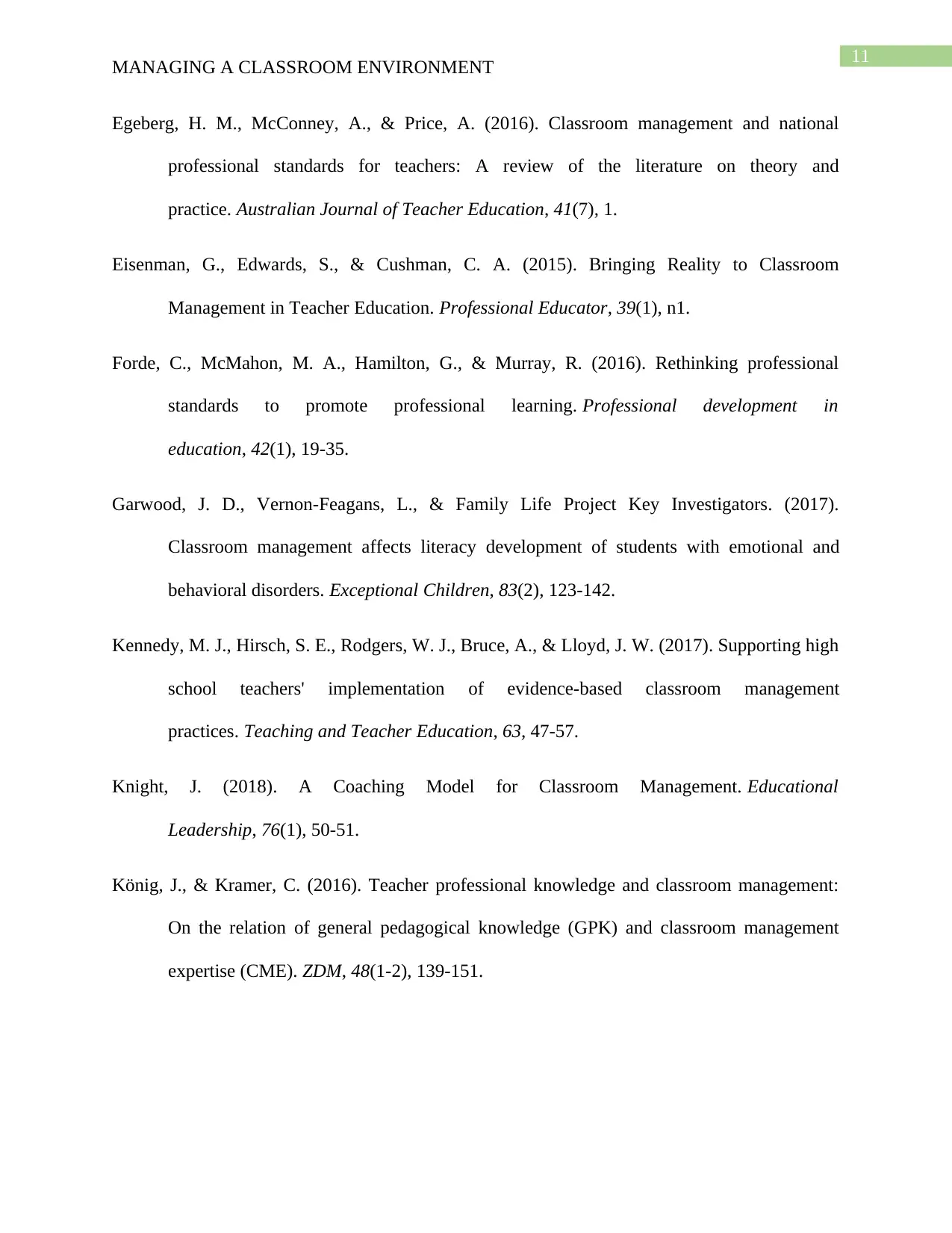
11
MANAGING A CLASSROOM ENVIRONMENT
Egeberg, H. M., McConney, A., & Price, A. (2016). Classroom management and national
professional standards for teachers: A review of the literature on theory and
practice. Australian Journal of Teacher Education, 41(7), 1.
Eisenman, G., Edwards, S., & Cushman, C. A. (2015). Bringing Reality to Classroom
Management in Teacher Education. Professional Educator, 39(1), n1.
Forde, C., McMahon, M. A., Hamilton, G., & Murray, R. (2016). Rethinking professional
standards to promote professional learning. Professional development in
education, 42(1), 19-35.
Garwood, J. D., Vernon-Feagans, L., & Family Life Project Key Investigators. (2017).
Classroom management affects literacy development of students with emotional and
behavioral disorders. Exceptional Children, 83(2), 123-142.
Kennedy, M. J., Hirsch, S. E., Rodgers, W. J., Bruce, A., & Lloyd, J. W. (2017). Supporting high
school teachers' implementation of evidence-based classroom management
practices. Teaching and Teacher Education, 63, 47-57.
Knight, J. (2018). A Coaching Model for Classroom Management. Educational
Leadership, 76(1), 50-51.
König, J., & Kramer, C. (2016). Teacher professional knowledge and classroom management:
On the relation of general pedagogical knowledge (GPK) and classroom management
expertise (CME). ZDM, 48(1-2), 139-151.
MANAGING A CLASSROOM ENVIRONMENT
Egeberg, H. M., McConney, A., & Price, A. (2016). Classroom management and national
professional standards for teachers: A review of the literature on theory and
practice. Australian Journal of Teacher Education, 41(7), 1.
Eisenman, G., Edwards, S., & Cushman, C. A. (2015). Bringing Reality to Classroom
Management in Teacher Education. Professional Educator, 39(1), n1.
Forde, C., McMahon, M. A., Hamilton, G., & Murray, R. (2016). Rethinking professional
standards to promote professional learning. Professional development in
education, 42(1), 19-35.
Garwood, J. D., Vernon-Feagans, L., & Family Life Project Key Investigators. (2017).
Classroom management affects literacy development of students with emotional and
behavioral disorders. Exceptional Children, 83(2), 123-142.
Kennedy, M. J., Hirsch, S. E., Rodgers, W. J., Bruce, A., & Lloyd, J. W. (2017). Supporting high
school teachers' implementation of evidence-based classroom management
practices. Teaching and Teacher Education, 63, 47-57.
Knight, J. (2018). A Coaching Model for Classroom Management. Educational
Leadership, 76(1), 50-51.
König, J., & Kramer, C. (2016). Teacher professional knowledge and classroom management:
On the relation of general pedagogical knowledge (GPK) and classroom management
expertise (CME). ZDM, 48(1-2), 139-151.
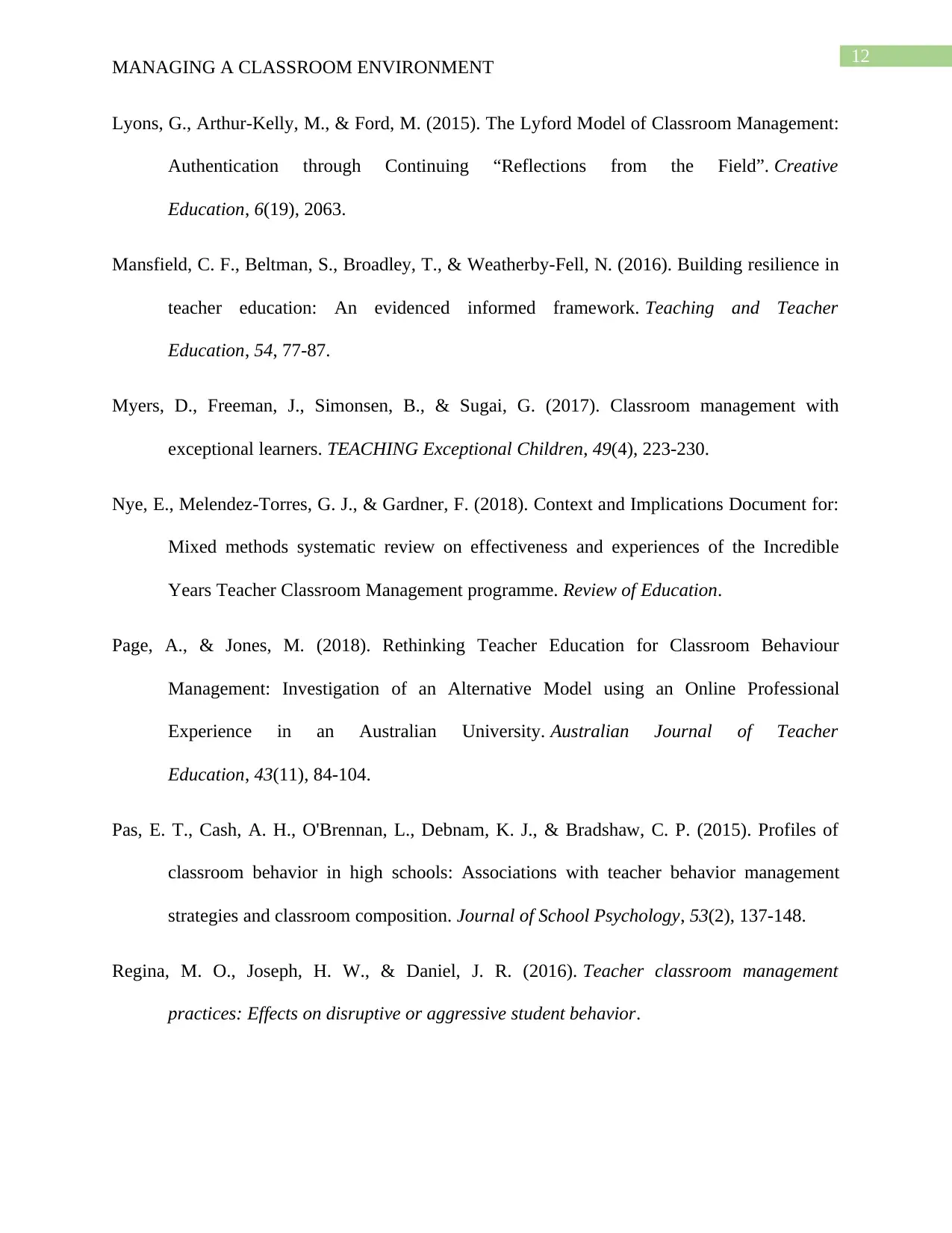
12
MANAGING A CLASSROOM ENVIRONMENT
Lyons, G., Arthur-Kelly, M., & Ford, M. (2015). The Lyford Model of Classroom Management:
Authentication through Continuing “Reflections from the Field”. Creative
Education, 6(19), 2063.
Mansfield, C. F., Beltman, S., Broadley, T., & Weatherby-Fell, N. (2016). Building resilience in
teacher education: An evidenced informed framework. Teaching and Teacher
Education, 54, 77-87.
Myers, D., Freeman, J., Simonsen, B., & Sugai, G. (2017). Classroom management with
exceptional learners. TEACHING Exceptional Children, 49(4), 223-230.
Nye, E., Melendez-Torres, G. J., & Gardner, F. (2018). Context and Implications Document for:
Mixed methods systematic review on effectiveness and experiences of the Incredible
Years Teacher Classroom Management programme. Review of Education.
Page, A., & Jones, M. (2018). Rethinking Teacher Education for Classroom Behaviour
Management: Investigation of an Alternative Model using an Online Professional
Experience in an Australian University. Australian Journal of Teacher
Education, 43(11), 84-104.
Pas, E. T., Cash, A. H., O'Brennan, L., Debnam, K. J., & Bradshaw, C. P. (2015). Profiles of
classroom behavior in high schools: Associations with teacher behavior management
strategies and classroom composition. Journal of School Psychology, 53(2), 137-148.
Regina, M. O., Joseph, H. W., & Daniel, J. R. (2016). Teacher classroom management
practices: Effects on disruptive or aggressive student behavior.
MANAGING A CLASSROOM ENVIRONMENT
Lyons, G., Arthur-Kelly, M., & Ford, M. (2015). The Lyford Model of Classroom Management:
Authentication through Continuing “Reflections from the Field”. Creative
Education, 6(19), 2063.
Mansfield, C. F., Beltman, S., Broadley, T., & Weatherby-Fell, N. (2016). Building resilience in
teacher education: An evidenced informed framework. Teaching and Teacher
Education, 54, 77-87.
Myers, D., Freeman, J., Simonsen, B., & Sugai, G. (2017). Classroom management with
exceptional learners. TEACHING Exceptional Children, 49(4), 223-230.
Nye, E., Melendez-Torres, G. J., & Gardner, F. (2018). Context and Implications Document for:
Mixed methods systematic review on effectiveness and experiences of the Incredible
Years Teacher Classroom Management programme. Review of Education.
Page, A., & Jones, M. (2018). Rethinking Teacher Education for Classroom Behaviour
Management: Investigation of an Alternative Model using an Online Professional
Experience in an Australian University. Australian Journal of Teacher
Education, 43(11), 84-104.
Pas, E. T., Cash, A. H., O'Brennan, L., Debnam, K. J., & Bradshaw, C. P. (2015). Profiles of
classroom behavior in high schools: Associations with teacher behavior management
strategies and classroom composition. Journal of School Psychology, 53(2), 137-148.
Regina, M. O., Joseph, H. W., & Daniel, J. R. (2016). Teacher classroom management
practices: Effects on disruptive or aggressive student behavior.
Paraphrase This Document
Need a fresh take? Get an instant paraphrase of this document with our AI Paraphraser
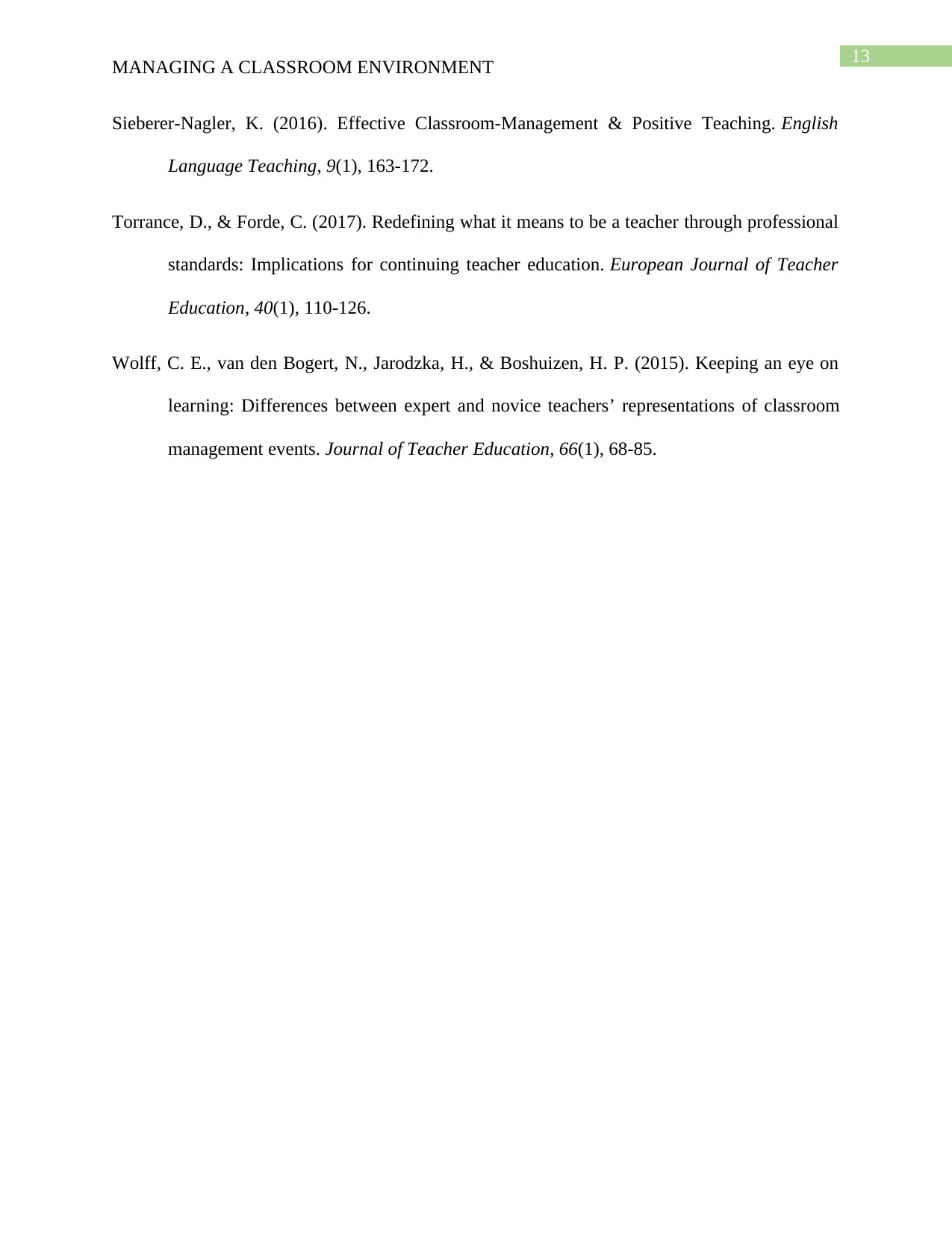
13
MANAGING A CLASSROOM ENVIRONMENT
Sieberer-Nagler, K. (2016). Effective Classroom-Management & Positive Teaching. English
Language Teaching, 9(1), 163-172.
Torrance, D., & Forde, C. (2017). Redefining what it means to be a teacher through professional
standards: Implications for continuing teacher education. European Journal of Teacher
Education, 40(1), 110-126.
Wolff, C. E., van den Bogert, N., Jarodzka, H., & Boshuizen, H. P. (2015). Keeping an eye on
learning: Differences between expert and novice teachers’ representations of classroom
management events. Journal of Teacher Education, 66(1), 68-85.
MANAGING A CLASSROOM ENVIRONMENT
Sieberer-Nagler, K. (2016). Effective Classroom-Management & Positive Teaching. English
Language Teaching, 9(1), 163-172.
Torrance, D., & Forde, C. (2017). Redefining what it means to be a teacher through professional
standards: Implications for continuing teacher education. European Journal of Teacher
Education, 40(1), 110-126.
Wolff, C. E., van den Bogert, N., Jarodzka, H., & Boshuizen, H. P. (2015). Keeping an eye on
learning: Differences between expert and novice teachers’ representations of classroom
management events. Journal of Teacher Education, 66(1), 68-85.
1 out of 14
Related Documents
Your All-in-One AI-Powered Toolkit for Academic Success.
+13062052269
info@desklib.com
Available 24*7 on WhatsApp / Email
![[object Object]](/_next/static/media/star-bottom.7253800d.svg)
Unlock your academic potential
© 2024 | Zucol Services PVT LTD | All rights reserved.





